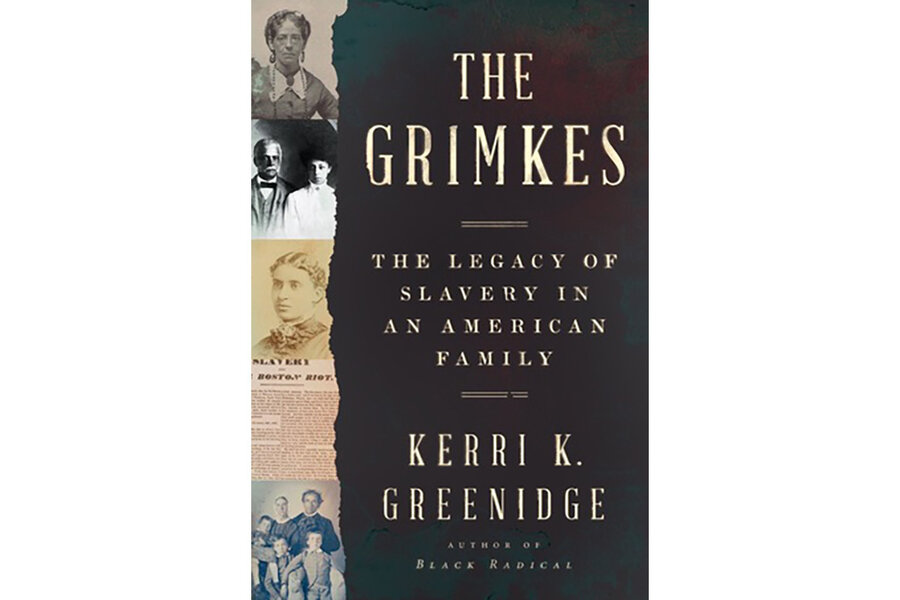Two white abolitionists discover Black family members. Complexity ensues.
Loading...
In 1868, Angelina Grimke read in an abolitionist newspaper about a “thrillingly, powerfully impressive” student named Archibald Grimke, enrolled at a Black college in Pennsylvania. That’s how Angelina and her sister Sarah, famous white abolitionists who’d forsaken their family’s South Carolina plantation decades earlier, came to learn that they had three Black nephews, the children of their late brother Henry and Nancy Weston, a woman he enslaved.
This moment arrives more than halfway through Kerri K. Greenidge’s gripping book “The Grimkes: The Legacy of Slavery in an American Family.” In its early chapters, the Tufts University historian tells of how the sisters, objecting to their family’s slaveholding, left the South, joined a Quaker community in Philadelphia, and became known for their abolitionist and feminist lectures and writings.
Greenidge also details the brutal childhood experiences of Archibald, known as Archie, and his brothers, Francis and John, under slavery. After the Civil War, their mother, with help from the Boston Freedmen’s Aid Commission, was able to send them north to be educated.
The book also introduces the Fortens, wealthy Black Philadelphians dedicated to building up Black community institutions but who also worked in uneasy alliance with white antislavery activists like the Grimke sisters. They have a place in the proceedings because one of the Fortens, Lottie, married Francis Grimke, known as Frank, in 1878.
All told, there are many characters to keep track of, and, while always compelling, the book’s first half jumps around among them. The narrative gains momentum when the storylines converge as Angelina and Sarah, who had always believed their brother Henry was “a kind master,” are confronted with living proof suggesting otherwise.
The famous sisters immediately embraced their nephews, promising to support them financially. While their acceptance of their Black relatives helped burnish Sarah and Angelina’s heroic reputations, Greenidge digs deeply into the family’s archives to reveal their complex and often severe treatment of their nephews.
Sarah was unmarried and had no children. Angelina was married to abolitionist Theodore Dwight Weld, and the couple had two sons and a daughter; all three were acknowledged by their parents and aunt to be unexceptional. Upon meeting her Grimke nephews, Angelina told them, “You, my young friends, now bear this once honored name. I charge you most solemnly, by your upright conduct and your life-long devotion to the eternal principles of justice and humanity and religion, to lift this name out of the dust where it now lies, and set it once more among the princes of our land.”
That fervent declaration set the tone for their relationship, which the author summarizes as a “combination of deep love and relentless criticism.” Greenidge writes that the price of their aunts’ affection was high: “the brothers’ unwavering personal and professional exceptionalism and constant genuflection before the Grimke sisters’ supposedly steep sacrifice. In exacting this price, the Grimke-Welds neither acknowledged Archie, Frank, or John’s actual needs nor accounted for their nephews’ trauma.”
Still, Archie and Frank willingly paid the price, making their aunts proud. (John eventually became estranged from the family.) Archie attended Harvard Law School and was a co-founder of the NAACP. At the end of the 19th century, he served as American consul to the Dominican Republic. Frank, after studying at the Princeton Theological Seminary, became the minister at the most prominent Black church in Washington.
In short, they were both stalwart members of “the colored elite,” a culturally conservative cohort for whom respectability was key. For instance, as a trustee of Washington’s “colored” schools, Frank moved to have two Black female teachers fired merely for getting married. Greenidge observes that the concerns of Archie, Frank, and other members of the elite ignored the harsh realities confronting the majority of Black people in post-Reconstruction America: lynching, legalized segregation, and Black disenfranchisement.
The weight of these two generations’ expectations came bearing down on Angelina Weld Grimke, known as Nana, born in 1880 to Archie and his white wife, who abandoned the family when Nana was a child. Frank and his wife, Lottie, had a daughter at almost the same time, but she died in infancy, making Nana the sole descendant. The baby’s death set in motion the devastating repetition of a painful family psychodrama: Just as Sarah and Angelina expected their nephews to stand in for the unremarkable next generation of white Grimkes, Frank and Lottie expected Nana to stand in for the daughter they’d lost.
Unlike Archie and Frank, however, Nana chafed against her family’s strict demands. She engaged in romantic relationships with girls from a young age, leading Frank and Lottie, her guardians while Archie served in Santo Domingo, to cast her out of their Washington home. “You are not becoming a young woman ... with whom the race can be proud,” Frank scolded in a letter. Lottie piled on: “I have loved you since you were born as if you were my own child. It pains me still that you fail us again and again.”
When Nana later fell in love with a man, her father, Archie, upset by the suitor’s skin color, worried that he would “darken the family line.” He forced Nana to choose between her boyfriend and him. Already abandoned by one parent, she chose Archie. Nana went on to become a Harlem Renaissance playwright and poet of some repute, but while Greenidge doesn’t say much about Nana’s later years, the impression is that they were lonely.
Nana’s literary work, in Greenidge’s words, punctured the lie told to her generation: “that elite educations, disavowal of their enslaved past, and economic success could compensate for their ancestors’ various racial traumas.” The author’s affecting account of Nana’s tragic life demonstrates that these traumas are not so easily overcome.








